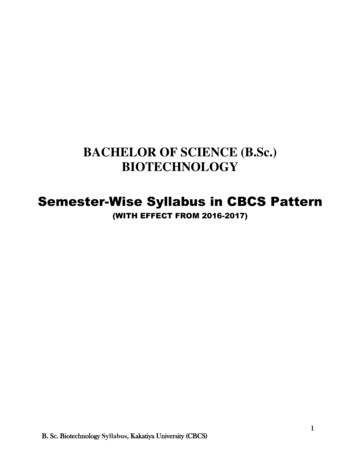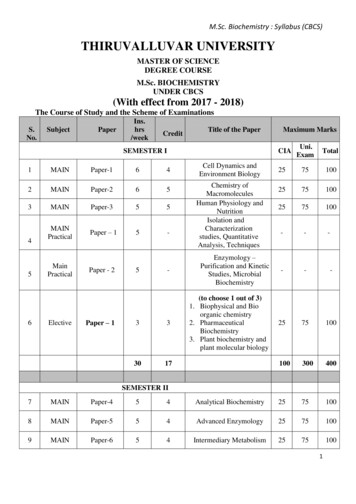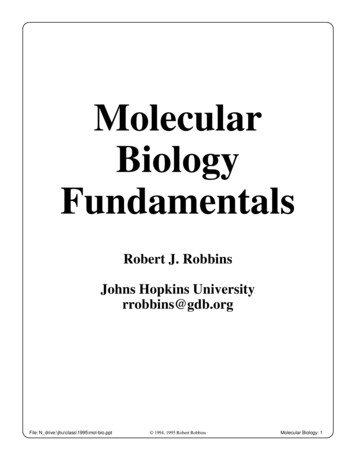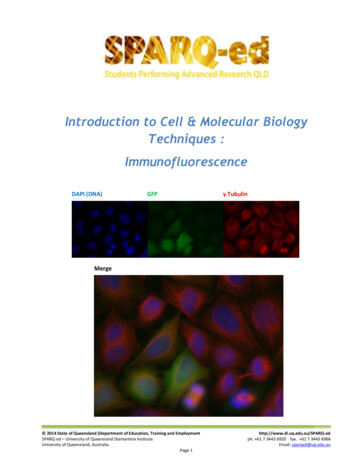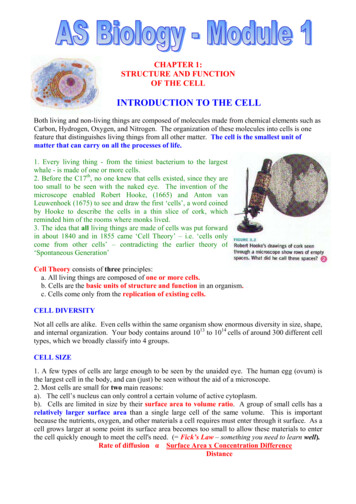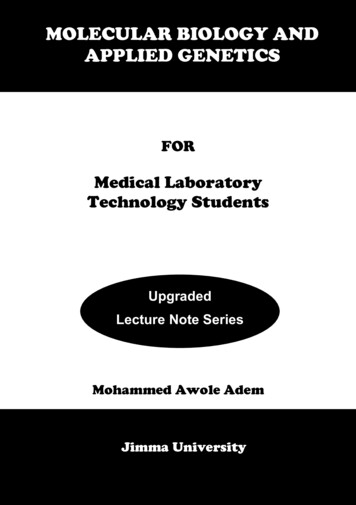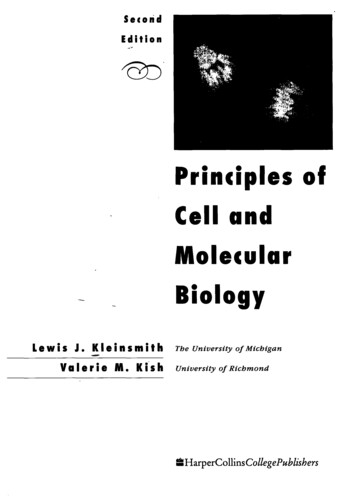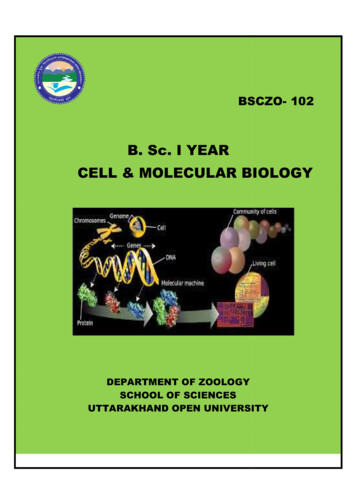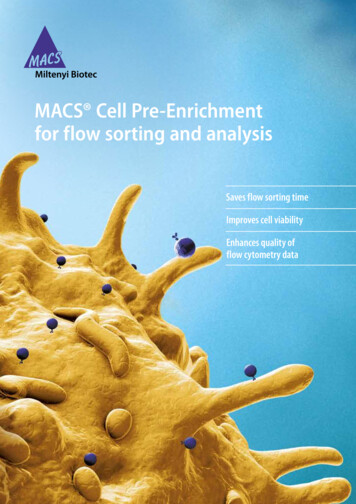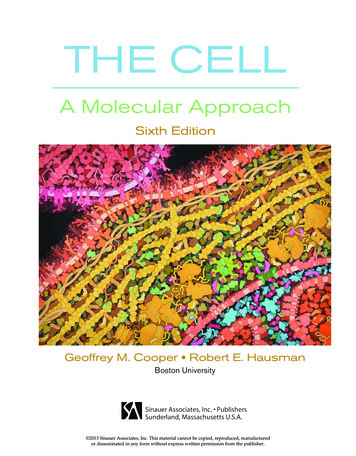
Transcription
THE CELLA Molecular ApproachSixth EditionGeoffrey M. Cooper Robert E. HausmanBoston UniversitySinauer Associates, Inc. PublishersSunderland, Massachusetts U.S.A. 2013 Sinauer Associates, Inc. This material cannot be copied, reproduced, manufacturedor disseminated in any form without express written permission from the publisher.
Brief ContentsPART IPART IIIIntroduction1Chapter 1 An Overview of Cellsand Cell Research 3Chapter 2 The Composition of Cells 43Chapter 3 Cell Metabolism 73Chapter 4 Fundamentals ofMolecular Biology 103PART IICell Structure and Function343Chapter 9 The Nucleus 345Chapter 10 Protein Sorting andTransport 373Chapter 11 Bioenergetics andMetabolism 421Chapter 12 The Cytoskeleton andCell Movement 459Chapter 13 The Plasma Membrane 515The Flow of GeneticInformation 151Chapter 5 The Organization and Sequencesof Cellular Genomes 153Chapter 6 Replication, Maintenance, andRearrangements of GenomicDNA 191Chapter 14 Cell Walls, the ExtracellularMatrix, and CellInteractions 557PART IVCell Regulation587Chapter 15 Cell Signaling 589Chapter 7 RNA Synthesis andProcessing 239Chapter 16 The Cell Cycle 641Chapter 8 Protein Synthesis,Processing, and Regulation 297Chapter 17 Cell Death and CellRenewal 681Chapter 18 Cancer 713 2013 Sinauer Associates, Inc. This material cannot be copied, reproduced, manufacturedor disseminated in any form without express written permission from the publisher.
ContentsPreface xixOrganization and Features of The Cell xxiMedia and Supplements to Accompany The Cell xxiiiPart IIntroduction1CHAPTER 1An Overview of Cells andCell Research 3The Origin and Evolution of Cells 4The first cell 4The evolution of metabolism 6Present-day prokaryotes 8Eukaryotic cells 9The origin of eukaryotes 10The development of multicellular organisms 13Cells as Experimental ModelsE. coli 17Yeasts 18Caenorhabditis elegans 18Drosophila melanogaster 19Arabidopsis thaliana 19Vertebrates 20Tools of Cell Biology 22Light microscopy 22Electron microscopy 28Subcellular fractionation 31Growth of animal cells in culture 32Culture of plant cells 36Viruses 36KEY EXPERIMENTAnimal Cell Culture 34MOLECULAR MEDICINEViruses and Cancer 3717Summary and Key Terms 39Questions 40References and Further Reading 41CHAPTER 2The Composition ofCells 43The Molecules of Cells 43Carbohydrates 44Lipids 46Nucleic acids 49Proteins 52Cell Membranes 58Membrane lipids 58Membrane proteins 59Transport across cell membranes 62Proteomics: Large-Scale Analysis of CellProteins 65Identification of cell proteins 65Global analysis of protein localization 67Protein interactions 68 2013 Sinauer Associates, Inc. This material cannot be copied, reproduced, manufacturedor disseminated in any form without express written permission from the publisher.
ContentsKEY EXPERIMENTixCHAPTER 4The Folding of Polypeptide Chains 54KEY EXPERIMENTThe Structure of Cell Membranes 62Summary and Key Terms 70Questions 71References and Further Reading 71CHAPTER 3Cell Metabolism73The Central Role of Enzymes as BiologicalCatalysts 73The catalytic activity of enzymes 73Mechanisms of enzymatic catalysis 74Coenzymes 76Regulation of enzyme activity 79Metabolic Energy 81Free energy and ATP 81The generation of ATP from glucose 84The derivation of energy from other organicmolecules 89Photosynthesis 90The Biosynthesis of Cell Constituents 91Carbohydrates 92Lipids 93Proteins 94Nucleic acids 98KEY EXPERIMENTAntimetabolites and Chemotherapy 97MOLECULAR MEDICINEPhenylketonuria 98Summary and Key Terms 99Questions 100References and Further Reading 101Fundamentals ofMolecular Biology103Heredity, Genes, and DNA 103Genes and chromosomes 103Genes and enzymes 105Identification of DNA as the genetic material 107The structure of DNA 108Replication of DNA 109Expression of Genetic Information 110Colinearity of genes and proteins 111The role of messenger RNA 112The genetic code 113RNA viruses and reverse transcription 115Recombinant DNA 118Restriction endonucleases 118Generation of recombinant DNA molecules 120Vectors for recombinant DNA 122DNA sequencing 124Expression of cloned genes 126Detection of Nucleic Acids and Proteins 127Amplification of DNA by the polymerase chainreaction 127Nucleic acid hybridization 129Antibodies as probes for proteins 132Gene Function in Eukaryotes 135Genetic analysis in yeasts 135Gene transfer in plants and animals 136Mutagenesis of cloned DNAs 139Introducing mutations into cellular genes 140Interfering with cellular gene expression 142KEY EXPERIMENTThe DNA Provirus Hypothesis 117KEY EXPERIMENTRNA Interference 144Summary and Key Terms 146Questions 148References and Further Reading 148 2013 Sinauer Associates, Inc. This material cannot be copied, reproduced, manufacturedor disseminated in any form without express written permission from the publisher.
xContentsPart II The Flow ofGenetic Information151CHAPTER 5The Organization andSequences of CellularGenomes 153CHAPTER 6The Complexity of Eukaryotic Genomes 153Introns and exons 155Repetitive DNA sequences 159Gene duplication and pseudogenes 161The Sequences of Complete Genomes 162The genomes of bacteria and yeast 163The genomes of Caenorhabditis elegans, Drosophilamelanogaster, and other invertebrates 165Plant genomes 166The human genome 166The genomes of other vertebrates 169Chromosomes and Chromatin 171Chromatin 172Centromeres 176Telomeres 180Replication, Maintenance,and Rearrangementsof Genomic DNA 191DNA Replication 191DNA polymerases 192The replication fork 193The fidelity of replication 200Origins and the initiation of replication 201Telomeres and telomerase: maintaining theends of chromosomes 205DNA Repair 207Bioinformatics and Systems Biology 181Systematic screens of gene function 181Regulation of gene expression 182Variation among individuals and genomicmedicine 184KEY EXPERIMENTThe Discovery of Introns 156KEY EXPERIMENTThe Human Genome 167Summary and Key Terms 186Questions 187References and Further Reading 188Direct reversal of DNA damage 208Excision repair 210Base-excision repair 210Nucleotide-excision repair 210Transcription-coupled repair 213Mismatch repair 213Translesion DNA synthesis 216Repair of double-strand breaks 216DNA Rearrangements219Site-specific recombination 219Transposition via DNA intermediates 227Transposition via RNA intermediates 228Gene amplification 232MOLECULAR MEDICINEColon Cancer and DNA Repair 215KEY EXPERIMENTRearrangement of Immunoglobulin Genes 220 2013 Sinauer Associates, Inc. This material cannot be copied, reproduced, manufacturedor disseminated in any form without express written permission from the publisher.
ContentsSummary and Key Terms 233Questions 235References and Further Reading 236KEY EXPERIMENTCHAPTER 7Summary and Key Terms 291Questions 293References and Further Reading 294RNA Synthesis andProcessing 239Transcription in Prokaryotes 239RNA polymerase and transcription 240Repressors and negative control oftranscription 243Positive control of transcription 245Eukaryotic RNA Polymerases and GeneralTranscription Factors 245Eukaryotic RNA polymerases 246General transcription factors and initiationof transcription by RNA polymerase II 246Transcription by RNA polymerases I and III 250Regulation of Transcription inEukaryotes 251cis-acting regulatory sequences: promoters andenhancers 251Transcription factor binding sites 255Transcriptional regulatory proteins 258Structure and function of transcriptionalactivators 260Eukaryotic repressors 263Regulation of elongation 264Relationship of chromatin structure totranscription 266Regulation of transcription by noncoding RNAs 271DNA methylation 273RNA Processing and Turnover 275Processing of ribosomal and transfer RNAs 275Processing of mRNA in eukaryotes 277Splicing mechanisms 279Alternative splicing 286RNA editing 288RNA degradation 289xiIsolation of a Eukaryotic Transcription Factor 259KEY EXPERIMENTThe Discovery of snRNPs 284CHAPTER 8Protein Synthesis,Processing, andRegulation 297Translation of mRNA 297Transfer RNAs 298The ribosome 299The organization of mRNAs and the initiation oftranslation 305The process of translation 307Regulation of translation 313Protein Folding and Processing 319Chaperones and protein folding 319Enzymes that catalyze protein folding 322Protein cleavage 323Glycosylation 325Attachment of lipids 327Regulation of Protein Function 329Regulation by small molecules 329Protein phosphorylation and othermodifications 330Protein-protein interactions 335Protein Degradation 335The ubiquitin-proteasome pathway 335Lysosomal proteolysis 338KEY EXPERIMENTCatalytic Role of Ribosomal RNA 304KEY EXPERIMENTThe Discovery of Protein-Tyrosine Kinases 333Summary and Key Terms 339Questions 340References and Further Reading 341 2013 Sinauer Associates, Inc. This material cannot be copied, reproduced, manufacturedor disseminated in any form without express written permission from the publisher.
xiiContentsPart III Cell Structureand Function 343CHAPTER 9The Nucleus345The Nuclear Envelope and Traffic betweenthe Nucleus and the Cytoplasm 345Structure of the nuclear envelope 346The nuclear pore complex 350Selective transport of proteins to and from thenucleus 353Regulation of nuclear protein import 356Transport of RNAs 357Internal Organization of the Nucleus 359Chromosome organization and gene expression 359Sub-compartments within the nucleus 362The Nucleolus and rRNA Processing 365Ribosomal RNA genes and the organization of thenucleolus 365Transcription and processing of rRNA 367Ribosome assembly 368Additional functions of the nucleolus 369MOLECULAR MEDICINENuclear Lamina Diseases 348KEY EXPERIMENTIdentification of Nuclear Localization Signals 352Summary and Key Terms 370Questions 371References and Further Reading 372CHAPTER 10Protein Sorting andTransport 373The Endoplasmic Reticulum 373The endoplasmic reticulum and proteinsecretion 374Targeting proteins to the endoplasmic reticulum 376Insertion of proteins into the ER membrane 381Protein folding and processing in the ER 386Quality control in the ER 389The smooth ER and lipid synthesis 392Export of proteins and lipids from the ER 395The Golgi Apparatus 398Organization of the Golgi 398Protein glycosylation within the Golgi 400Lipid and polysaccharide metabolism in theGolgi 402Protein sorting and export from the Golgiapparatus 403The Mechanism of Vesicular Transport 406Experimental approaches to understanding vesiculartransport 406Cargo selection, coat proteins, andvesicle budding 407Vesicle fusion 410Lysosomes 412Lysosomal acid hydrolases 412Endocytosis and lysosome formation 414Phagocytosis and autophagy 416 2013 Sinauer Associates, Inc. This material cannot be copied, reproduced, manufacturedor disseminated in any form without express written permission from the publisher.
ContentsKEY EXPERIMENTThe Signal Hypothesis 378MOLECULAR MEDICINEGaucher Disease 413Questions 457References and Further Reading 458CHAPTER 12Summary and Key Terms 417Questions 419References and Further Reading 419The Cytoskeleton andCell Movement 459CHAPTER 11Structure and Organization of ActinFilaments 459Bioenergetics andMetabolism 421Mitochondria 421Organization and function of mitochondria 422The genetic system of mitochondria 424Protein import and mitochondrial assembly 425The Mechanism of OxidativePhosphorylation 431The electron transport chain 431Chemiosmotic coupling 432Transport of metabolites across the innermembrane 436Chloroplasts and Other Plastids 438The structure and function of chloroplasts 438The chloroplast genome 440Import and sorting of chloroplast proteins 441Other plastids 444Photosynthesis 446Electron transport 446ATP synthesis 449Peroxisomes 450Functions of peroxisomes 451Peroxisome assembly 453MOLECULAR MEDICINEDiseases of Mitochondria:Leber’s Hereditary Optic Neuropathy 426KEY EXPERIMENTThe Chemiosmotic Theory 434Summary and Key Terms 455xiiiAssembly and disassembly of actin filaments 460Organization of actin filaments 465Association of actin filaments with the plasmamembrane 467Protrusions of the cell surface 471Actin, Myosin, and Cell Movement472Muscle contraction 473Contractile assemblies of actin and myosin innonmuscle cells 477Unconventional myosins 479Formation of protrusions and cell movement 480Microtubules 482Structure and dynamic organization ofmicrotubules 482Assembly of microtubules 485Organization of microtubules within cells 488Microtubule Motors and Movement490Identification of microtubule motor proteins 490Cargo transport and intracellular organization 493Cilia and flagella 496Reorganization of microtubules during mitosis 499Chromosome movement 500Intermediate Filaments 502Intermediate filament proteins 502Assembly of intermediate filaments 504Intracellular organization of intermediatefilaments 505Functions of intermediate filaments: keratins anddiseases of the skin 507KEY EXPERIMENTThe Isolation of Kinesin 491 2013 Sinauer Associates, Inc. This material cannot be copied, reproduced, manufacturedor disseminated in any form without express written permission from the publisher.
xivContentsKEY EXPERIMENTCHAPTER 14Expression of Mutant KeratinCauses Abnormal Skin Development 508Summary and Key Terms 510Questions 512References and Further Reading 512Cell Walls, the ExtracellularMatrix, and CellInteractions 557CHAPTER 13Cell Walls 557The Plasma Membrane515Structure of the Plasma Membrane 515The phospholipid bilayer 515Membrane proteins 519Mobility of membrane proteins 524The glycocalyx 525Transport of Small Molecules 526Passive diffusion 526Facilitated diffusion and carrier proteins 527Ion channels 529Active transport driven by ATP hydrolysis 537Active transport driven by ion gradients 540Endocytosis 544Bacterial cell walls 557Eukaryotic cell walls 557The Extracellular Matrix and Cell-MatrixInteractions 564Matrix structural proteins 564Matrix polysaccharides 568Matrix adhesion proteins 569Cell-matrix interactions 571Cell-Cell Interactions 574Adhesion junctions 574Tight junctions 577Gap junctions 578Plasmodesmata 581KEY EXPERIMENTThe Characterization of Integrin 572Phagocytosis 544Receptor-mediated endocytosis 545Protein trafficking in endocytosis 550MOLECULAR MEDICINECystic Fibrosis 541KEY EXPERIMENTMOLECULAR MEDICINEGap Junction Diseases 580Summary and Key Terms 582Questions 583References and Further Reading 584The LDL Receptor 548Summary and Key Terms 553Questions 554References and Further Reading 555 2013 Sinauer Associates, Inc. This material cannot be copied, reproduced, manufacturedor disseminated in any form without express written permission from the publisher.
Part IV Cell Regulation587ContentsxvPart IV CellRegulation 587CHAPTER 15Cell Signaling589Signaling Molecules and TheirReceptors 589Modes of cell-cell signaling 590Steroid hormones and the nuclear receptorsuperfamily 591Nitric oxide and carbon monoxide 593Neurotransmitters 594Peptide hormones and growth factors 594Eicosanoids 596Plant hormones 598Functions of Cell Surface Receptors 599G protein-coupled receptors 600Receptor protein-tyrosine kinases 603Cytokine receptors and nonreceptor protein-tyrosinekinases 606Receptors linked to other enzymatic activities 607Pathways of Intracellular SignalTransduction 608The cAMP pathway: second messengers and proteinphosphorylation 608Cyclic GMP 611Phospholipids and Ca2 612The PI 3-kinase/Akt and mTOR pathways 615MAP kinase pathways 617The JAK/STAT and TGF-b/Smad pathways 623NF-kB signaling 625The Hedgehog, Wnt, and Notch pathways 625Signal Transduction and theCytoskeleton 628Integrins and signal transduction 628Signaling from cell adhesion molecules 630Regulation of the actin cytoskeleton 630Signaling Networks 632Feedback and crosstalk 632Networks of cellular signal transduction 634KEY EXPERIMENTG Protein-Coupled Receptors and OdorDetection 601MOLECULAR MEDICINECancer: Signal Transductionand the ras Oncogenes 620Summary and Key Terms 635Questions 637References and Further Reading 638CHAPTER 16The Cell Cycle641The Eukaryotic Cell Cycle 641Phases of the cell cycle 642Regulation of the cell cycle by cell growth andextracellular signals 644Cell cycle checkpoints 646Restricting DNA replication to once per cellcycle 647Regulators of Cell Cycle Progression 647Protein kinases and cell cycle regulation 647Families of cyclins and cyclin-dependentkinases 653Growth factors and the regulation of G1 Cdk’s 655DNA damage checkpoints 658The Events of M Phase 659Stages of mitosis 659Entry into mitosis 662The spindle assembly checkpoint and progressionto anaphase 666 2013 Sinauer Associates, Inc. This material cannot be copied, reproduced, manufacturedor disseminated in any form without express written permission from the publisher.
xviContentsCytokinesis 667KEY EXPERIMENTMeiosis and Fertilization 668Culture of Embryonic Stem Cells 702The process of meiosis 668Regulation of oocyte meiosis 671Fertilization 673Summary and Key Terms 708Questions 710References and Further Reading 710KEY EXPERIMENTThe Discovery of MPF 649KEY EXPERIMENTThe Identification of Cyclin 652Summary and Key Terms 675Questions 677References and Further Reading 677CHAPTER 17Cell Death and CellRenewal 681Programmed Cell Death 681The events of apoptosis 682Caspases: the executioners of apoptosis 685Central regulators of apoptosis: the Bcl-2family 686Signaling pathways that regulate apoptosis 689Alternative pathways of programmed cell death 692Stem Cells and the Maintenance of AdultTissues 692Proliferation of differentiated cells 693Stem cells 695Medical applications of adult stem cells 701Pluripotent Stem Cells, CellularReprogramming, andRegenerative Medicine 703Embryonic stem cells 704Somatic cell nuclear transfer 705Induced pluripotent stem cells 707Transdifferentiation of somatic cells 708CHAPTER 18Cancer713The Development and Causes ofCancer 713Types of cancer 713The development of cancer 715Causes of cancer 717Properties of cancer cells 718Transformation of cells in culture 722Tumor Viruses 723Hepatitis B and C viruses 723Small DNA tumor viruses 724Herpesviruses 726Retroviruses 726Oncogenes 727Retroviral oncogenes 727Proto-oncogenes 728Oncogenes in human cancer 731Functions of oncogene products 735Tumor Suppressor Genes 741Identification of tumor suppressor genes 741Functions of tumor suppressor gene products 745Roles of oncogenes and tumor suppressor genes intumor development 748Molecular Approaches to CancerTreatment 749Prevention and early detection 749Treatment 750KEY EXPERIMENTThe Discovery of Proto-Oncogenes 730KEY EXPERIMENTIdentification of Genes Requiredfor Programmed Cell Death 684MOLECULAR MEDICINEImatinib: Cancer Treatment Targetedagainst the bcr/abl Oncogene 752 2013 Sinauer Associates, Inc. This material cannot be copied, reproduced, manufacturedor disseminated in any form without express written permission from the publisher.
ContentsSummary and Key Terms 755Questions 757References and Further Reading 757Answers to Questions 761Glossary 773Illustration Credits 797Index 799 2013 Sinauer Associates, Inc. This material cannot be copied, reproduced, manufacturedor disseminated in any form without express written permission from the publisher.xvii
Organization and Features of The Cell xxi Media and Supplements to Accompany The Cell xxiii Part I Introduction 1 CHAPTER 1 An Overview of Cells and Cell Research 3 The Origin and Evolution of Cells 4 The first cell 4 The evolution of metabolism 6 Present-day pro
